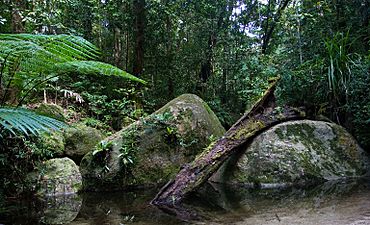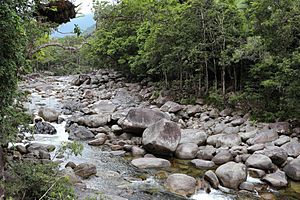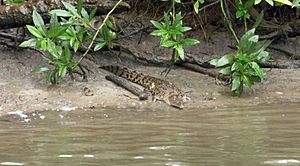Daintree National Park facts for kids
Quick facts for kids Daintree National ParkQueensland |
|
|---|---|
|
IUCN Category II (National Park)
|
|

A typical rainforest scene in Daintree National Park
|
|
| Nearest town or city | Daintree |
| Established | 1988 |
| Area | 1,200 km2 (463.3 sq mi) |
| Managing authorities | Queensland Parks and Wildlife Service |
| Website | Daintree National Park |
| See also | Protected areas of Queensland |
The Daintree rainforest is a special national park in Far North Queensland, Australia. It's about 1,757 km (1,092 mi) northwest of Brisbane and 100 km (62 mi) northwest of Cairns. This amazing park was created in 1981. It's part of the larger Wet Tropics of Queensland area. In 1988, it became a World Heritage Site, which means it's super important globally!
The park has two main parts. There's a farming area between them, where you'll find the towns of Mossman and Daintree Village.
One way to enter Daintree National Park is south of the Daintree River, at a place called Mossman Gorge. Here, there's a visitor center. From there, tourists can take a shuttle bus to the gorge. You can enjoy a walk or even a refreshing swim in the water.
The most amazing and oldest part of the Daintree rainforest is north of the Daintree River. To get there, you cross the river on an old-fashioned cable ferry. Once you're across, you can explore many boardwalks and beautiful, untouched beaches. Keep an eye out for the endangered cassowary bird; you might spot one anywhere!
Daintree National Park is very important because it has an incredible variety of plants and animals. It's a key home for rare species and lots of different birdlife. The park gets its name from the Daintree River. An early explorer named George Elphinstone Dalrymple named the river after his friend Richard Daintree.
Contents
Exploring Daintree: Mossman Gorge Section
In this part of Australia, the Great Dividing Range mountains are very close to the coast. The Mossman Gorge section of the park covers a huge area of 56,500 hectares. Most of this area is made up of rainforests and mountain woodlands that are hard to reach.
The popular Mossman Gorge is in the southern part of the park. It's about 75 kilometers north of Cairns. You can get there by driving along the Captain Cook Highway to Mossman. The gorge offers many beautiful walking trails. These include Baral Marrjanga, the Lower River Track, Rex Creek Bridge, and the Rainforest Circuit Track. This area is home to amazing plants and animals. You might see a Boyd’s forest dragon or a Victoria’s riflebird here.
Exploring Daintree: Cape Tribulation Section
Cape Tribulation is also part of Daintree National Park. It used to be its own national park starting in 1981. But in 1983, it joined Daintree National Park. This section covers 17,000 hectares. It includes coastal mountains like Thornton's Peak, Mount Hemmant, and Mount Sorrow. These mountains are north of the Daintree River.
This area has Australia's last large areas of lowland rainforest. It also has long, beautiful, and mostly untouched beaches. These beaches stretch from Thornton Beach to Cape Tribulation Beach. They are lined with special rainforest that grows right by the sea. This type of rainforest is becoming rare. The Daintree River forms the southern edge of this region. You need to take a cable ferry to cross it.
The traditional owners of Daintree National Park are the Eastern Kuku Yalanji Aboriginal people. Many natural places in the park are very important to them spiritually. One interesting spot is where the bouncing stones are found at Thornton Beach. These rocks are called hornfels. They are special rocks that formed when hot granite pushed into other rocks. They are very springy when you bounce them on the ground! The park also includes the Mossman River in the south, and the Daintree River and Bloomfield River in the north.
Amazing Plants of the Daintree
Most of Daintree National Park is covered by a thick tropical rainforest. The Greater Daintree Rainforest has been around for more than 110 million years. This makes it possibly the oldest rainforest still existing today!
Scientists believe this rainforest has survived so long because of how the continents moved over time. After a huge supercontinent broke apart, one piece drifted towards the South Pole and became Antarctica. This changed ocean currents and made things very cold. Other pieces moved to hotter, drier places. But the rainforests of the original continent kept their climate. Because of this, their ancient trees also survived. Some tree species that people thought were long extinct have only recently been found here!
Wonderful Animals of the Daintree
The park is home to more than 430 different kinds of birds. The wompoo fruit-dove is one of six types of pigeons living in the park. You can also find many cassowary birds here. Cassowaries are large, flightless birds that are endangered. The buff-breasted paradise kingfisher visits the park during certain seasons.
Many mammals live here too. These include the striped possum, Daintree River ringtail possum, brown bandicoot, long-nosed bandicoot, and the musky rat-kangaroo. You might also see a Bennett’s tree kangaroo, swamp wallaby, platypus, and short-beaked echidna.
At least 23 types of reptiles and 13 types of amphibians call the park home. Some of the reptiles you might spot are the Boyd's forest dragon, eastern water dragon, chameleon gecko, and northern leaf-tailed gecko. There are also snakes like the scrub or amethystine python, keelback, and the green and northern tree snakes.
Frogs found in the park include the Australian lacelid, white-lipped treefrog, colourful-eyed treefrog, and common mist frog. Unfortunately, the introduced cane toad is also present in the park.
Images for kids
See also
 In Spanish: Parque nacional Daintree para niños
In Spanish: Parque nacional Daintree para niños







